Micro Moves Of Elite Golf Swings
- by Kelvin Miyahira
After analyzing thousands of high speed video golf swings of elite PGA and long drive competitors, Rick and I have come to the conclusion that much of what we have been taught to “see” via traditional instruction is just the rough surface of what’s going on. Understanding elite golf swings as well as dysfunctional ones are much easier when you have an understanding of the deeper, “micro moves” that underlie the larger movements of the golf swing. Though it may seem a bit more complicated, the analysis and the treatment become simple when you have a roadmap to all the moves you need to have.
Sometimes these micro moves have a sequence and sometimes they don’t. But oftentimes it is enough to know whether a certain move exists in a swing or not. Typically, the absence of a micro move will lead to either loss of power or a dysfunctional move somewhere down the line. Thus, if you’re going to find and cure the root cause of a swing problem, you must be able to trace the obvious swing errors back to these missing micro moves.
Also, sometimes these micro moves are caused by certain muscles or muscle groups. To aid us in this understanding, Dr. Douglas Hayes has joined forces with us in developing deeper insights into human movements. He is incredibly knowledgeable about the way the muscles work and has had experience working with PGA tour pros as a soft tissue massage/chiropractic practitioner.
It is helpful to have his understanding of how muscles work, how they are connected to bone structures, origin of muscle, insertion points and whether they are working as stabilizers or prime movers. Therefore sometimes, in the interest of being as specific and accurate in the English language as we can, we must label the micro move by the muscle or by its anatomical movement name. This will definitely aid in our understanding and hopefully prevent any loss in translation.
Micro moves
So let me start by defining what a micro move is. Basically, micro moves are like the individual genes that make up your swing’s DNA. For example, when a teacher says to “shift your weight” what does that really entail? Or, “you’re coming over the top. Let’s get the club on plane.” Well, we know the answers to those questions are not so simple and they involve many micro moves.
Seeing the Micro Moves
A micro move is so small that sometimes only high speed video captures it (even so-called high-tech biomechanical systems like the K-Vest, Golftec and TPI 3D are not looking for these moves, therefore won’t find it). We’re shooting videos at 300 or 600 frames per second and sometimes at 1200 frames per second to catch the action of individual muscle firings. Normal camcorders shooting at 30 or 60 frames per second will miss many of the moves or catch them in midstream. In other words, if you took video of a bouncing ball and two consecutive frames captured the ball in mid-bounce, it would seem as though the ball wasn’t moving or never moved. Thus, the need for high speed video is immensely important.
A micro move cannot be seen by the naked eye, though Rick might be able to see them since he’s studying swings so much. So if you want to see these moves, turn down the volume on your TV set (for best results, hit the mute button…….shhhhhh Mr. Kostis) and watch the Konica Minolta SwingVision shots on CBS carefully. In our modern, technological world, this should be our way of “digging it out of the dirt” as Ben Hogan would say.
Or, get yourself a Casio high speed camera and start seeing what’s really going on in your own swing. You don’t have to get the top-of-the-line Casio EX-F1 that Rick and I have. Casio has introduced several small point and shoot digital cameras like the EX-FS10 that shoot 210 frames per second and cost less than $300 on Amazon and other online dealers. With a great digital camera like that, who needs a camcorder?
Who uses the Micro Moves?
Micro moves are performed by the elite golfers most likely without their knowledge. They just swing that way. I’m sure Jamie Sadlowski can’t tell you which of the micro moves he uses. Nor could Tiger, Bubba, Rory, Camilo or Alvaro. But these moves are there in the most athletic and powerful swings.
Also, micro moves are not only for golfers. They are in the motions of great baseball hitters, pitchers, tennis players, hockey players, football players, basketball players and more. When athletes use micro moves during their movements, it represents the best way they can move. Take a look at the pitching motion of Tim Lincecum as an example of a pitcher using all these micro moves. Or Roger Federer using micro move called wrist flexion during his awesome forehand.
Yet oddly enough, micro moves are the opposite of what many people would call “efficient.” Many people believe that we should eliminate all extraneous motions and that this will make you better or more consistent. NOT!
Thus, the majority of the weekend warriors do not use these micro moves. Some people may think that we lose these micro moves a little because we get old and stiff, but that’s not true. There are some great senior and super senior long drive hitters that can absolutely nuke it. So that’s not the reason.
Undoubtedly, we lose these micro moves because of poor instruction. Some popular swing theories seek to eliminate these micro moves from the swing. Forty years ago, it was a given that you should keep your head absolutely still and your left arm rigidly straight. Now we know that’s not true.
Today there are popular ideas in current instruction that are eliminating micro moves yet are being blindly accepted on the basis of marketing appeal and simple athletic illogic. It sends golfers flocking to the Kool Aid to drink without any scrutiny. Perhaps it will take a few more decades before the masses realize the damage it is doing.
But you don’t have to wait for a few decades of waning performance before its too late. You can be on the cutting edge and start looking at these micro moves and better yet, begin using them now.
Remember, the removal of these micro moves will cause a loss of power and worse yet, will cause a golfer to have chronic swing problems unless you resurrect these micro moves.
Another way to lose these micro moves is via subtle changes in posture due to exercise and improper training. In another article, Dr. Hayes and I will discuss postureology and its effects on the golf swing in a future article.
Why do we need Micro Moves?
Each micro move is there for a reason. This goes back to stretch shorten cycles (SSC) and how we can use our body to the fullest potential. The most powerful way to use your body is to make use of these SSC’s because we can generate more power by stretching before contracting.
Simply put, each micro move is a trigger to start a SSC and obtain a powerful reflex action that follows. If we focus on the micro moves, we won’t have to “try” to get the next move, it will just happen. And by adding a micro move or two, you can really change your swing in a positive way. It will remove the flaws from your swing by pulling them out from the roots, not just clipping the top of the weed off.
Also, these micro moves are set up sequentially to produce the greatest amount of speed and power for your golf swing.
If I don’t have the Micro Moves can I still be good?
Yes you can. However, it is at a diminished level. Let’s say we take out all your leg movements, given that you want the same distance but could only use the top half of your body. Wouldn’t that make your upper body overwork? Wouldn’t that also cause dysfunction? Sure it would.
So the bottom line is that missing pieces to the puzzle will always affect the outcome. So try to get these moves because if not, you aren’t swinging optimally as your body is designed to do.
List of micro moves
Dr. Hayes, Rick and I are still finding more micro moves each week. Thus, the list of micro moves will likely increase over time.
It’s more than a Plane
So let’s just start by taking a closer look at one of the most common problem afflicting golfers………the over the top error and how you can use these micro moves to get your club on plane.
So let me start by saying you just can’t put the club on plane. I think many of you saw the hit series on the golf channel called “The Haney Project” with Charles Barkley. Did Sir Charles get any better? Haney showed us his lack of communication skills and true understanding of the micro moves that comprise a good golf swing. Repeating the same words over and over again and expecting a different result is the sign of……………..golf instruction insanity?
So here are two still shots were taken from the last episode in the series and he’s doing basically the same things he was doing at the start of the series. Whether he pauses, double pumps or not, it doesn’t matter. The flaws are still there.

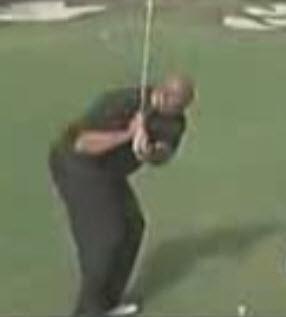
Charles is missing the three micro moves that could surely help him. So let’s use this roadmap and see how simple fixing him could have been.
Elbow Move
Charles’ most glaring missing micro move is one that we call the elbow move. Simply put, the elbow should move faster than the hands at the start of the downswing. This is similar to a second baseman flipping a ball to first base. The elbow leads the hand at the initiation of the forward movement. The difficulty with feeling this that you have two hands on the golf club so it is hard for some golfers to feel this move.
But Charles does not throw like a second baseman. Instead, he does more of a pie throwing down motion where he moves his hands first. By doing pie throwing move, he can only do the dreaded over-the-top move (macro move that we all can see). Also, he’s losing speed by not being able to tap into the external rotation of the right shoulder that is so powerful in throwing motions.
Jamie’s Awesome Elbow Move
So what do elite golfers do? I’ve drawn a yellow line through Jamie Sadlowski’s right forearm to indicate the starting position. After a few frames you will be able to see a pattern.
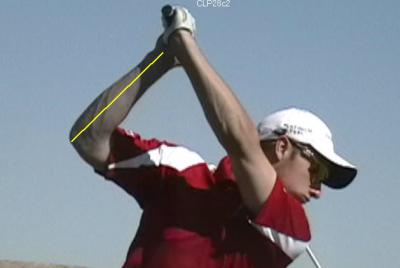
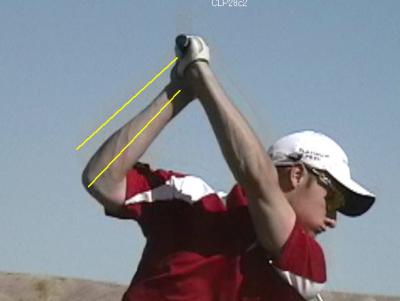
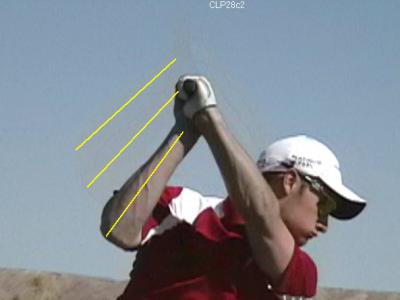
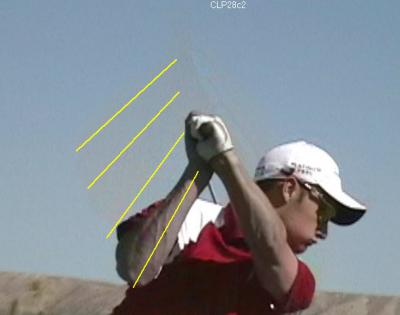
By this frame you can really see that his elbow has moved a lot faster than his hands at the start of the downswing.
There are other great examples of players with a great elbow move. Alvaro Quiros, the bomber that hit the 300 yard, uphill and against the wind second shot to the par 5 when Tiger was on the green, has a great elbow move. Lucas Glover has a great one as well.


Back/Side Arch Move
The next move that Sir Charles is missing is the back/side arch move (there are more micro moves involved in this move but I’ll just start with the general idea) and it is the reason his head dips down. As the downswing starts, elite golfers show a high degree of creasing in their shirts just below the rib cage. It is the obliques (side abdominal muscles), rotator cuff, quadratus lumborum and latissimus muscles on the right side that are contracting to hold back and increase the stretch in the left side of your torso. It also is responsible for the right shoulder dropping lower as I will show later.
Without this muscle firing, Charles fires everything he’s got at the start of the downswing instead of sequencing properly.
Here’s Tiger at the top of his backswing at Hazeltine. Notice the looseness of the shirt on the right side of his rib cage/oblique area.
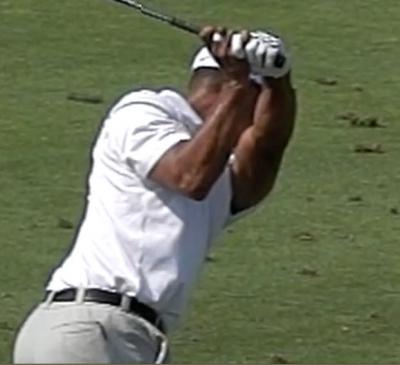
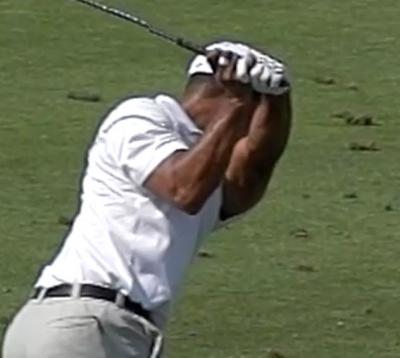
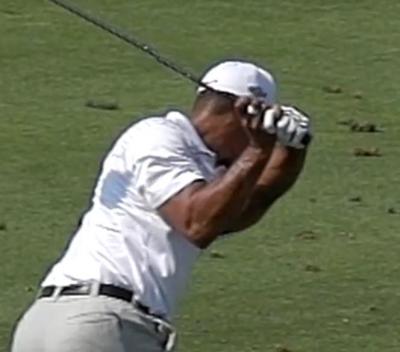
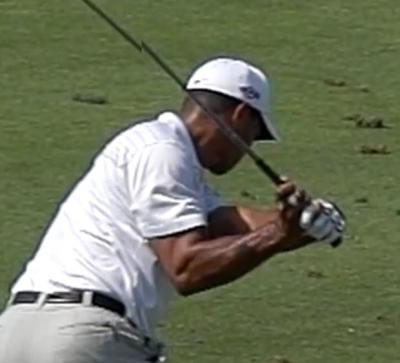
The creases are starting.
By this point, you can really see all the creases building in his shirt.
Thus, without this oblique firing, what chance does Charles have of keeping his head up on the downswing? And if Haney repeats “head up” or “keep your head up” one billion times, would it ever make any difference? Doubtful.
Stop Sign move
I mentioned this move in a previous article, the feeling you get is that your right hand is turning away from the target as you start the downswing. This starts the process of closing the clubface or resisting the moment of inertia in the club to rotate open.
This move is actually occurring in both hands. The left wrist turns from a cupped position into a more flat wrist position as it starts down. Some are flat wrist at the top and it will become more bowed as they start down.
In a dysfunctional swing, the right hand will turn palm up as it succumbs to the moment of inertia and allows the clubface to open more. This is the pattern of a slicer or at the very least the root cause of a golfer becoming a flipper.
Let’s take a look at Jamie’s hand movements.
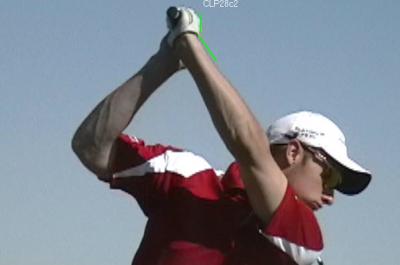
I’ve drawn these lines in different colors so you can see the changes in the angle.

Here the angle has become wider.
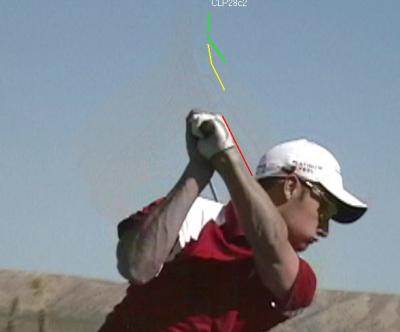
By this point his wrist has become flat.
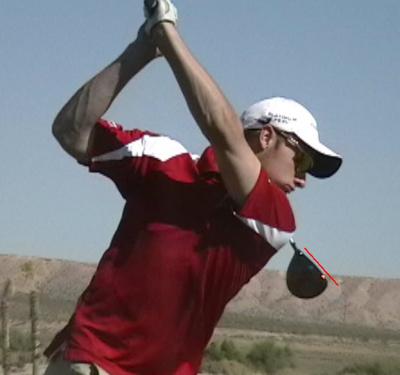
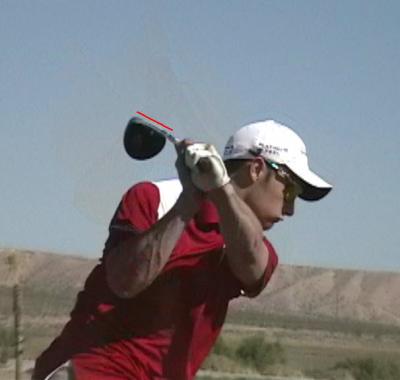
Look at what this does to the clubface angle. This is how he can hit it straight and far. Many of the slicers out there definitely have the face opening as the downswing starts. Make the change here and say goodbye to the slice.
Shoulder Move
If the back arches and the elbow moves correctly (via rotator cuff and lat muscle pulling), we should see a bigger movement of the shoulders that is distinct. The shoulders move in a down and around pattern. Here’s Dewald Gouws runner-up from last year’s World Long Drive championships showing his shoulder move.

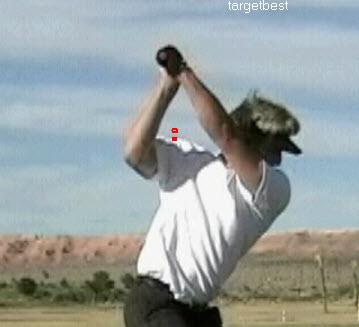
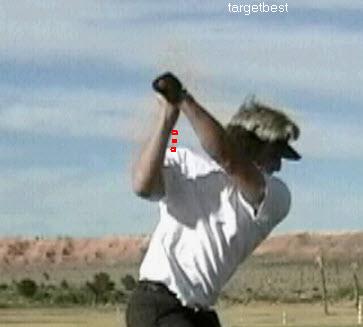
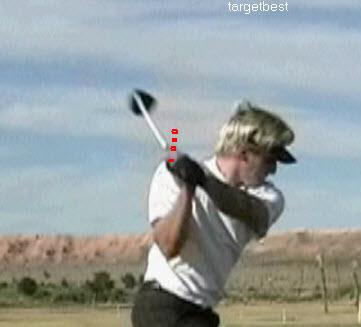

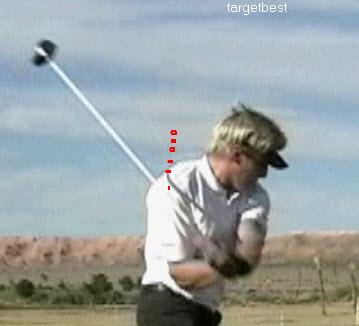
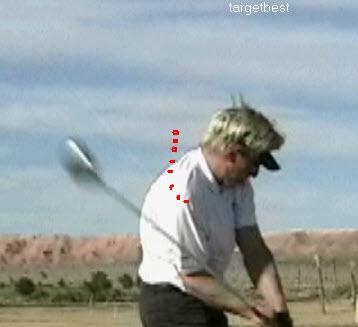
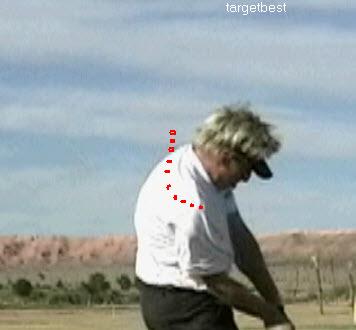
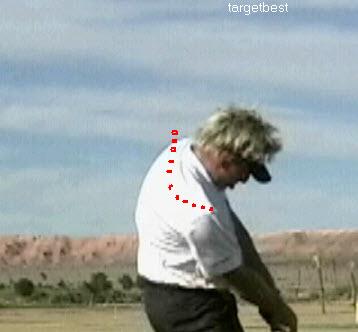
Dysfunctional shoulder moves travel in a straight line to the ball. It’s the shortest distance between the two points but does it really matter when it ruins the sequencing of everything else?


Is there any doubt as to what these three micro moves can do for you? Would you rather swing like Alvaro or Charles?
The choice is yours.
There are many more micro moves to be covered in future articles so we’ll just tackle a few at a time. Next month we’ll be doing something on postureololgy and the way that your posture can influence your swing patterns.

